|
 Campanella vinosolivida Campanella vinosolivida
BiostatusPresent in region - Indigenous. Endemic
Images (click to enlarge)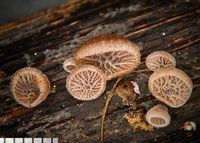
Owner: J.A. Cooper | 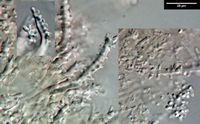
Caption: cap hairs
Owner: J.A. Cooper | 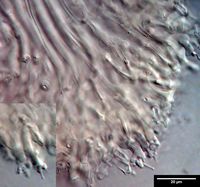
Caption: cheilocystidia and gill trama
Owner: J.A. Cooper | 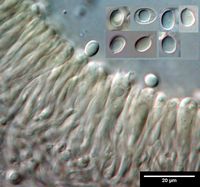
Caption: basidia and spores (Melzers)
Owner: J.A. Cooper | 
Caption: Campanella vinosolivida. 1, Basidiomes;
2, spores; 3, basidia: 4, cheilocystidia; 5, pileipellis elements. | 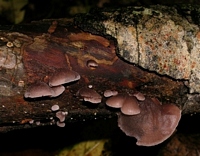
Owner: J.A. Cooper | 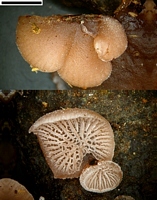
Caption: scale=5mm
Owner: J.A. Cooper | 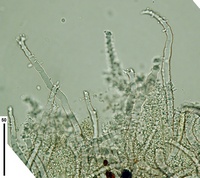
Caption: cap hairs in Melzers
Owner: J.A. Cooper | 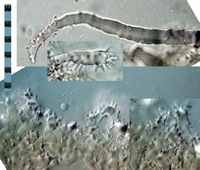
Caption: Top: cap hairs. Bottom: cheilocystidia
Owner: J.A. Cooper | 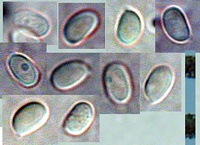
Caption: spores
Owner: J.A. Cooper | 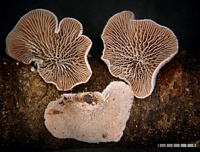
Owner: J.A. Cooper | 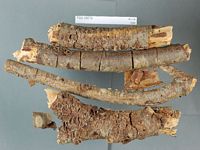
Caption: Dried type specimen
Owner: Herb PDD | |
Article: Segedin, B.P. (1993). Studies in the Agaricales of New Zealand: some new and revised species of Campanella (Tricholomataceae: Collybieae). New Zealand Journal of Botany 31: 375-384 (http://www.rsnz.org/publish/abstracts.php).
Description: Basidiome conchate to orbicular, sessile,
attached dorsally, centrically to excentrically, gelatinous when fresh, drying
hard and horny. Pileus 3-30 mm diam., convex, livid vinaceus (12C4) drying light
greyish-brown (5E3), surface floccose especially when dry, and margin even,
thin. Hymenophore concolorous, favoloid in the centric to excentric middle region
(depending on point of attachment) from which up to 14 main lamellae radiate,
separated by 2-3 series of crowded lamellulae, all connected by very frequent
cross-veining at a somewhat lower level. Lamellae fairly narrow and relatively
thin. Flesh gelatinous. Smell and taste unknown.
Spore print pure white. Spores 6.0-7.0 x
3.5-4.0 (6.0 x 3.6) µm, Q = 1.6, elliptic-oblong, sometimes slightly ovoid,
fairly uniform in size, hyaline, inamyloid, not dextrinoid or cyanophilic, thin-walled,
with a very small apiculus. Basidia 15-17 x 4-5 µm, clavate, with 4 long (-6
µm) sterigmata. Cheilocystidia 18-25 x 4-5 µm, hyaline, thin-walled, sinuato-cylindric
to ventricose, ail apically diverticulate to nodulose, forming a sterile margin.
Pleurocystidia absent. Trama of narrow (2-4 µm diam.), moderately gelatinised
hyphae with conspicuous medallion clamp connections, interwoven to subparallel.
Subhymenium similarly gelatinised, very narrow and not easily distinguished.
Context of very strongly gelatinised, extremely narrow hyphae, with some broader
ones (-5 µm diam.) with oily yellow contents. Pileipellis of narrow (-4 µm diam.)
hyphae with yellow (in KOH) plasmatic pigment, giving rise to erect, diverticulate
to well-developed asterostromelloid elements.
Habitat: Gregarious on fallen wood of unknown species
in indigenous podocarp-dicotyledonous forest.
Notes: ETYMOLOGY:
The name reflects the colour of fresh basidiomes.
The colour and morphology and the small spores
of this species indicate affinities with C. purpureobrunnea Petch from
Sri Lanka, and C. boninensis (s. Ito & Imai) Parmasto from Japan
and CIS (formerly USSR) (Petch 1926; Parmasto 1981; Pegler 1986). It differs
from them, however, in having well-developed cystidia, more elliptical spores
and more complex pileipellis elements. Superficially C. vinosolivida
could be confused with the New Zealand species Marasmiellus violaceogriseus
(Stevenson) Horak both in colour and habit but can be distinguished by having
almost favoloid lamellae in the middle of the hymenophore, conspicuous interveining
between the outer lamellae and a straight margin, whereas M. violaceogriseus
has no interveining and a strongly inrolled margin, at least in early stages.
|